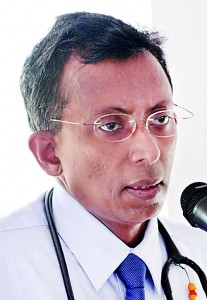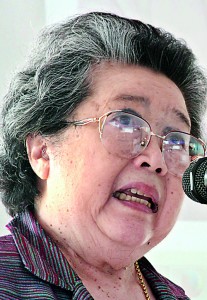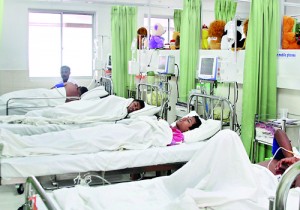News
Unique dengue management centre proudly completes one year
It is a year since it was opened and the celebrations on Tuesday were justified, for the ‘unique’ Centre for the Clinical Management of Dengue and Dengue Haemorrhagic Fever at Negombo has seen many a critically-ill man, woman and child go back home after treatment.
‘Unique’ it is being called because it is the only centre in the world managing and treating both adults and children, with Physicians and Paediatricians working together with the patients’ best interests at heart.

Dr. LakKumar Fernando: Founder of the centre
In a reflection of the dengue situation in the country, the centre was crowded with patients, while the first anniversary was being celebrated amidst an eminent gathering which included clergy from all religions, high-level officials of the Health Ministry, Dr. Champa Aluthweera, Medical Superintendent of the Negombo District General Hospital, politicians, doctors and well-wishers. Prof. Suchitra Nimmannitya, the Thai doyen who changed the course of dengue management, saving numerous lives, was also present.
Within the seven months of 2014, there have been 20,160 cases of dengue reported across the country, with the Western Province, comprising, Colombo, Gampaha and Kalutara, being the worst-affected
The ‘success story’ of this centre dubbed the ‘mother of dengue management’ is doubly important as it is severely short-staffed. Where there is a need for 18 Medical Officers to work on a shift basis, there are only seven. However, at any given time, there are always two doctors on duty at the centre, the Sunday Times understands.
Based on the concept of “dengue being a predictably treatable disease and both adults and children can be cured on the same principles of management”, that Consultant Paediatrician Dr. LakKumar Fernando mooted the idea of setting up the centre after coming under the influence of not only Prof. Suchitra but also her ‘golaya’, Prof. Siripen Kalayanarooj. Bitter and sad had been Dr. Fernando’s experiences before the Thai training in 2010. For in 2009, when he was serving at the Gampaha Hospital, of the 346 dengue deaths across the country, 64 had been in the Gampaha district.

Prof. Suchitra Nimmannitya addressing the gathering
In Thailand, he realised that Sri Lanka had “a lot to learn and what we were doing was not right”. There was an urgent need to change the management of dengue, but would any dramatic changes be possible. When he realised that changes would be slow in coming, he approached the World Health Organisation’s Representative, Dr. Firdosi Rustom Mehta. This became the tiny ripple that has led to bringing in new Guidelines for the Clinical Management of this dreaded disease.
It was in 2011 that Dr. Fernando approached the Health Ministry for funds and the Sunday Times recalls the disused and dilapidated ‘shed’ at the Negombo Hospital where motorcycles were parked and dogs and cattle lounged around, which has now been converted into the state-of-the-art Dengue centre.
This is where Dr. Fernando and his dedicated team of doctors and nurses have made sure that “if a patient is brought in alive, however ill, even with severe bleeding, the centre would turn the condition of the patient around”.
Over the past year, the centre has treated 1,318 patients of whom 1,133 had been serologically proven to have dengue fever (DF) or dengue haemorrhagic fever (DHF). The ‘profile’ of those treated includes DHF patients with severe disease; DF patients with rapidly dropping platelets and hepatic (liver) involvement; DF patients with bleeding manifestations; DF patients in the extremities of age, infants and elderly; and DF patients with co-morbidities (other illnesses). The ‘complicated’ dengue patients had included those with acute liver failure (181), acute kidney injury (2), dengue encephalopathy (2) and myocardial (heart) dysfunction (2).
The oldest patient had been 84 years old and the youngest just six days old, the Sunday Times learns.
About 93% of the patients had been serologically confirmed as having DF and not just by the low platelets or the progressively dropping platelet counts. This is one factor which probably makes the centre stand out from other institutions treating so-called dengue patients.
Comparing and contrasting earlier practices and what the centre is performing now, a presentation made by Dr. J.P.N. de Alwis during the celebrations pointed out that earlier DHF was diagnosed on clinical grounds and by the use of packed cell volume (PCV) counts and other blood tests. The centre goes a step further now and uses a series of ultrasound scanning to detect fluid leakage in patients very early and follow up leakage progression to confirm “true” DHF.

A success story: The Centre for Clinical Management of Dengue and Dengue Haemorrhagic Fever at Negombo
Ultrasound scanning is safe, painless and accurate in diagnosing DHF, was the message which emerged and the centre has not used this facility only internally but also in the medical and paediatric wards of the Negombo Hospital and extended it to other provincial hospitals as well.
Major improvements in the management of dengue have been experienced in the Gampaha District since the centre became a reality. With the district having nearly 4,000 dengue patients last year, 50% had been treated at the Negombo Hospital and this centre. Whereas there had been 64 deaths in the district in 2009, the number had dropped drastically to 13, last year, with the deaths occurring elsewhere in the district. Not a single death has been recorded at Negombo.
Justifiably it is proven that the Negombo centre has influenced the dengue case fatality rates, while setting new and high standards of managing and treating this disease.
As Dr. de Alwis explained, the “defining edge” at the Negombo centre could be put down to the utilisation of the knowledge of dengue experts both paediatricians and physicians, 24-hour continuous and vigorous monitoring by both medical and nursing staff, sophisticated patient monitoring equipment with superior reliable parameter readings, round-the-clock ultrasound scanning facility and regular clinical meetings to look inwards and evaluate and scrutinise patient management………“so we know how much better our care can be”.
With the Negombo centre setting the standard of care in dengue for others to follow, he said: “The notion that ‘dengue kills’ has become a thing of the past for us and it should be so for the whole country.”
While commending not only the south-south collaboration between Thailand and Sri Lanka which acted as the trigger for the setting up of the Negombo centre and then between Pakistan and Sri Lanka when the country’s experts curbed an epidemic in Pakistan, it was WHO’s Dr. Mehta who paid the best tribute.
“It’s a home-grown and sustained initiative,” said Dr. Mehta, dubbing it a “centre of excellence”.

